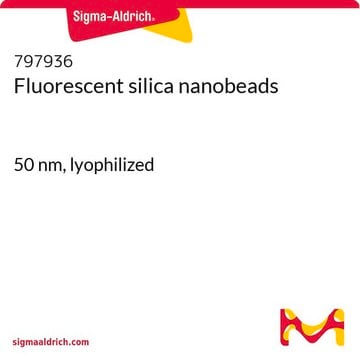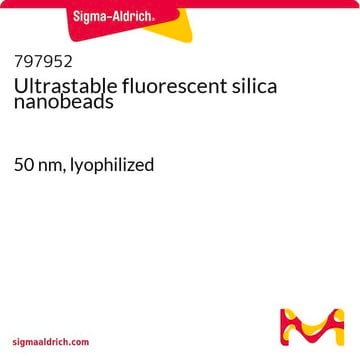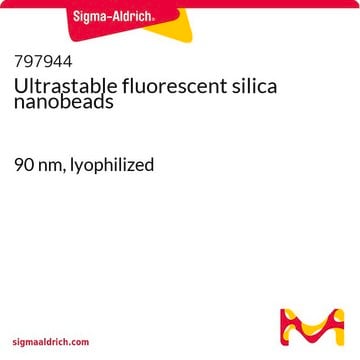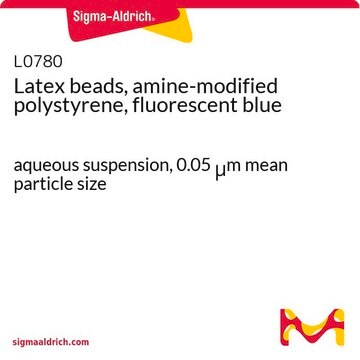The 25 nm nanobeads may exhibit high surface energy, making them prone to aggregation in solvent, which could explain the observed particle size of 300–800 nm in DLS measurements. It's also important to note that the 30% amplitude setting does not provide a clear indication of the actual power being applied during sonication. For better results, it is generally recommended to use a protocol of 1 second on with 3 seconds off for a total of 15 minutes under 400 Watts. Additionally, checking TEM images for the particle size, if available, may provide more accurate information on the actual size of the nanobeads.
797901
Ultrastable fluorescent silica nanobeads
25 nm, lyophilized
Synonim(y):
Fluorescent beads, Fluorescent nanoparticles, Silica nanoparticles
Wybierz wielkość
2200,00 zł
Wybierz wielkość
About This Item
2200,00 zł
Polecane produkty
Poziom jakości
Formularz
powder
wielkość cząstki
25 nm
fluorescencja
λem 590 nm
absorpcja UV
λ: 570 nm Amax
temp. przechowywania
2-8°C
Szukasz podobnych produktów? Odwiedź Przewodnik dotyczący porównywania produktów
Powiązane kategorie
Zastosowanie
Kod klasy składowania
11 - Combustible Solids
Klasa zagrożenia wodnego (WGK)
WGK 3
Temperatura zapłonu (°F)
Not applicable
Temperatura zapłonu (°C)
Not applicable
Wybierz jedną z najnowszych wersji:
Masz już ten produkt?
Dokumenty związane z niedawno zakupionymi produktami zostały zamieszczone w Bibliotece dokumentów.
Klienci oglądali również te produkty
Produkty
RAFT polymerization controls chain growth, yields defined polymers without cytotoxic heavy metals like ATRP.
Biomaterials science integrates smart materials into biological research, requiring a deep understanding of biological systems.
-
I applied probe sonication on ice for 8 minutes at 30% amplitude. However, the DLS size measurement results showed the particle size of is around 300–800 nm, which differs from the product description (25 nm). How?
1 answer-
Helpful?
-
-
Are these PFA-fixable?
1 answer-
A specific PFA Fixation study is not performed on this material. The literature around this topic seems to suggest this is a possible use for this product and more details can be found below.
Chiou AE, Hinckley JA, Khaitan R, Varsano N, Wang J, Malarkey HF 5th, Hernandez CJ, Williams RM, Estroff LA, Weiner S, Addadi L, Wiesner UB, Fischbach C. Fluorescent Silica Nanoparticles to Label Metastatic Tumor Cells in Mineralized Bone Microenvironments. Small. 2021 Apr;17(15):e2001432. doi: 10.1002/smll.202001432. Epub 2020 May 28. PMID: 32462807; PMCID: PMC7704907.
Further application information can be found on the website through the link below.
Helpful?
-
-
what is dispersibility of this beads in water.
1 answer-
The nanopowder may be re-dispersed by adding water directly to the storage vial. It is recommended to add 1 mL of water per each 1 mg of nanoparticles to be re-dispersed, and probe sonicating on ice for 8 minutes at 30% amplitude or until the powder has completely re-dissolved.
Helpful?
-
Active Filters
Nasz zespół naukowców ma doświadczenie we wszystkich obszarach badań, w tym w naukach przyrodniczych, materiałoznawstwie, syntezie chemicznej, chromatografii, analityce i wielu innych dziedzinach.
Skontaktuj się z zespołem ds. pomocy technicznej








